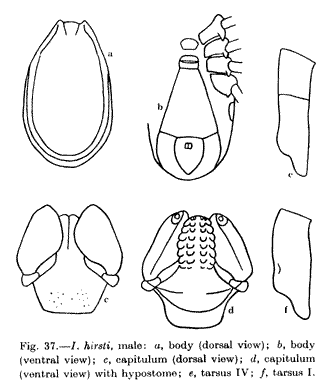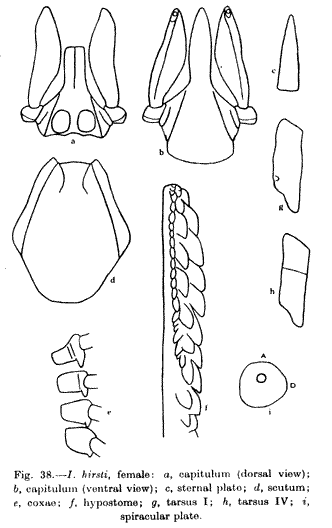IXODES HIRSTI Hassall (cat tick)
from Roberts FHS (1960): A systematic study of the Australian species of the genus Ixodes (Acarina: Ixodidae). Australian Journal of Zoology 8:392-485.
Ixodes hirsti Hassall, 1931, p 232. Roberts, 1959, p 268.
Ixodes victoriensis Hirst, 1930, pp. 575-6 (not Ixodes victoriensis Nuttall, 1916, pp. 297-8).
?Ixodes holocyclus Schulze, 1935, p. 36, fig. 5 (identity doubtful)
The nymph and larva of this species are unknown.
Male
Fig. 37, a-f
Body, oval with narrow marginal body fold, scutum with numerous fine punctations and with complete lateral grooves, appearing as mild carinae anteriorly: capitulum short and broad, dentition 2/2 of shallow, rounded teeth; anal plate bluntly pointed posteriorly; adanal plates curving to blunt points which fuse posterior to anal plate; coxae I-III with internal and external spurs, coxa IV with a single, small spur; tarsi with mild subapical humps.

Fig. 37.-I.hirsti, male: a, body (dorsal view); b, body (ventral view); c, capitulum (dorsal view); d, capitulum (ventral view) with hypostome; e, tarsus IV; f, tarsus I.
Description
Body. - Oval, 3.0 - 3.3 mm by 1.7 - 1.9 mm just posterior to coxa IV, marginal body fold very narrow, a little wider posteriorly; hairs few and scattered dorsally, more numerous ventrally.
Capitulum. - Short and broad, 0.50 - 0.67 mm in length; basis dorsally with lateral fields somewhat swollen and the median field mildly punctate, 0.4 mm wide, posterior margin straight, posterolateral margins straight and divergent anteriorly, no cornua; basis ventrally with short, obliquely transverse ridges adjacent to palpal insertions; palpi short and broad, article I longer externally than internally and ridge-like ventrally; articles 2 and 3 apparently fused, 0.35 - 0.40 mm in length, very broad, the width at mid length 0.23 mm.
Hypostome 0.35 mm in length with parallel sides and rounded apex. dentition 2/2 of about 6 rows of rounded teeth with a ridge-like row basally.
Scutum. - Only slightly smaller than body. oval, convex, lateral grooves complete, appearing as mild carinae anteriorly and becoming shallow and progressively wider posteriorly; punctations fine and numerous: cervical grooves short, shallow, convergent; emargination moderate; scapulae blunt.
Genital aperture. - At level of coxa III.
Ventral plates. - Pregenital plate hexagonal, 0.36 by 0.30 mm; median plate 1.46 by 1.00 mm, widest towards the posterior margin; anal plate 0.57 by 0.50 mm, the anterior margin straight or slightly convex, the lateral margins curved convergently posteriorly to form a blunt point; adanal plates with anterior margin straight, curving to fuse behind anal plate; punctations on plates scattered.
Spiracular plate.-Elongate oval, narrower posteriorly than anteriorly, the longer axis directed anteriorly, 0.57 mm in length.
Legs-Length moderate and with hairs longer and denser than on body; coxae almost contiguous, relatively flat, with a row of long hairs near the posterior margins, coxae I-III with mild internal and well-defined external spurs, the internal spur largest on coxa I and about equal in size, on coxae II and III, the external spurs becoming progressively smaller posteriorly, coxa IV somewhat triangular, with a single, small, external spur; tarsi with mild subterminal humps, tarsus I 0.66 mm in length, tarsus IV 0.69 mm in length.
Female
Fig. 38, a-i
Diagnosis
A large tick when engorged; scutum longer than wide and widest just posterior to mid-length, with strong lateral carinae; capitulum long, the palpi slender, elongate, the basis with well-developed carinae dorsally and ventrally, no cornua, porose areas large, deep, oval, pointed auriculae present, hypostome lanceolate, dentition mainly 3/3, file 3 of small crowded teeth; sternal plate present, elongate triangular; coxae I and II with anteriorly directed ridges, all coxae with an external spur, that on coxa IV much reduced.
Description
Body. -Partly fed specimens 3.4 by 2.8 mm, body broadly oval, semi engorged specimens frequently widest between coxa IV and spiracles, engorged specimens to 15.4 by 11.4 mm widest in region of anus; marginal grooves well developed and complete, on engorgement; posterolateral and median grooves well defined; some small, scattered, pale hairs present.
Capitulum.- 1.3-1.6 mm in length; basis dorsally 0.78 mm wide, median field depressed and separated from the raised lateral fields by strong carinae -which extend from the base of mouthparts to the posterior margin close to the posterolateral angles, the posterior margin a little sinuous, the posterolateral margins straight or slightly curved and divergent anteriorly, no cornua., basis ventrally with a mildly convex posterior margin and 2 strong carinae which terminate in pointed auriculae; porose areas large, subcircular or broadly oval, deep, almost contiguous with the posterior margin and the carinae, the interval depressed and less than the width of one; palpi long and slender, 1.0 - 1.2 mm in length, article I wider than long, rounded and somewhat salient laterally, and with a keel-like flange ventrally, articles 2 and 3 apparently fused, narrow at base and distally, and widest just posterior to the mid-length, the greatest width being about one-quarter the length.

Fig.38- I. hirsti, female: a, capitulum (dorsal view); b, capitulum (ventral view); c, sternal plate; d, scutum; e, coxae; f, hypostome; g, tarsus I; h, tarsus IV; I, spiracular plate
Hypostome 0.9-1.0 mm in length, somewhat lanceolate, the apex bluntly pointed; dentition mainly 3/3, 2/2 basally, file 3 composed of about 20 crowded, very small teeth, files 1 and 2 with about 16 teeth, indistinct distally.
Scutum.- Longer than wide, 2.5-2.8 mm bs, 2.0-2.2 mm and widest just posterior to mid-length, flat, medianly, convex laterally; lateral carinae strong and attaining posterior margin; anterolateral margins sinuous, posterolateral margins a little concave, posterior angle broadly rounded, punctations fine and scattered medianly, more numerous and a little coarser laterally; cervical grooves short and convergent continuing for a short distance posteriorly as divergent, shallow depressions; emargination moderate; scapulae bluntly pointed.
Genital aperture- position varying from third intercoxal space to a level with coxa IV; sternal plate somewhat variable in shape, but usually elongate triangular, the apex sometimes a little rounded, length 0.6 - 0. 8 mm, the width at base about one-quarter the length.
Genital grooves. - divergent posterior to genital aperture, then curving convergently to posterior margin of body.
Anal grooves. - rounded in front then curving convergently behind to meet at a point.
Spiracular plate. - subcircular, the longer axis transverse, 0.43 - 0.50 mm wide.
Legs. -Slender and of moderate length; coxae each with a row of hairs near posterior margin and a moderate external spur which becomes progressively smaller posteriorly, that on coxa IV being relatively inconspicuous, coxae I and II with anteriorly directed ridges; tarsi with mild subapical humps, tarsus I 0.86 - 0.94 mm in length, tarsus IV 0.84 - 0.93 mm in length.
Hosts and Distribution
Material examined- NEW SOUTH WALES: Wallabia bicolor, Mt. Irvine, Blue Mountains 11.vii.1950, 1 E female ; "Tasmanian wallaby", Taronga Park Zoological Gardens, Sydney, 18.viii.1927, 1 E ; Rattus assimilis, Colo Vale, 22.i.1957, 1 E VICTORIA: Felis catis, Selby, 6.xi.1957, 1 E female ; Phascolarctos cinereus, Sassafras 1951, 6.ii.1951, 2 E females; Cape Otway, 29.xi.1951, 2 GG males (damaged), 12 EE females; Cape Otway, 29.i.1932, 1 G male; Wallabia bicolor, Lower Tarwin, 24.xi.l925, 1 G male , 2 EE females . TASMANIA: "kangaroo", King I., 2.x.1935, 1E female ; Mt. Wellington, 15.xi.l937, 1E female . Hirst (1930) has recorded this species also from Pseudocheirus peregrinus, Lower Tarwin, Vic.
Comments
This species was originally described by Hirst, (1930) as I. victoriensis, the name being subsequently changed by Hassall (1931) to I. hirsti as it was preoccupied by Nuttall's (1916) I. victoriensis from the wombat.
The description of this species by the author agrees closely with the salient features noted by Hirst (1930).
Of the five species of Sternalixodes, I. hirsti is closest to I. confusus. In the males of both species the lateral grooves appear anteriorly as mild carinae, but in the male of I. confusus these grooves are interrupted to reappear posteriorly, whereas in I. hirsti they are continuous, although shallow. In I. confusus also, the trochanters in the male are armed, whereas in I. hirsti trochantal spurs are absent. The females in both species possess coxae with longitudinal ridges and can be separated by this character from the females of I. confusus, I. holocyclus and I. trichosuri. In this sex also, the basis ventrally has 3 carinae in I. confusus and only 2 in I. hirsti and in the former also the trochanters are spurred, whereas in the latter spurs are absent. The species determined arid figured by Schulze (1935) as I. holocyclus could be I. hirsti.
The Paralysis Tick of Australia - Home
E-mail Us to report a broken link!